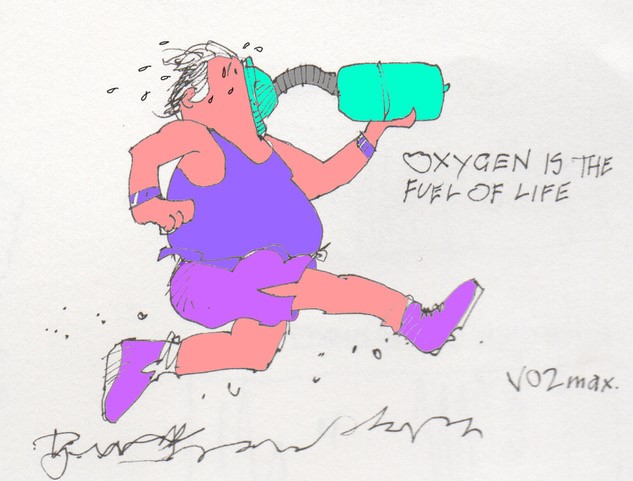PHYSICAL FITNESS AND OXYGEN UPTAKE
VO2max
In my last Blog I described the concept of oxygen uptake – VO2 – and of maximum oxygen uptake – VO2max. The concept of VO2max is very important. It is the most precise measure we have of physical fitness. It describes the maximum work rate of which a person is capable. In healthy young people it is usually between 35 and 55 ml/min/kg body weight (10-15 METs – see last Blog). In ultra-fit athletes it may reach levels of 70-80 ml/min/kg; heart patients tend to have much lower levels in the range of 10-30ml/min/kg. As we age there is a decline in VO2max of roughly 0.5 to 1.0 ml/min/kg each year.
Oxygen uptake
When we exercise, the necessary increase in oxygen uptake and transport is achieved by breathing harder while the heart pumps out more blood. This increase in “cardiac output” (CO) is mediated by an increase in heart rate and an increase in the volume pumped out by each heart beat, known as the stroke volume (SV).
With increasing exercise, the CO and oxygen uptake rise steadily to the point at which the body is incapable of increasing its level of exertion. Oxygen uptake levels off because it is as great as can be sustained – maximal oxygen uptake or VO2max. By this time there has been a four- to five-fold increase in CO, mediated by a more than doubling of heart rate to 180 to 200 per minute and a less than doubling of stroke volume to about 130ml.
Sufficient exertion to achieve maximal oxygen uptake can only be performed with the leg muscles. The lesser bulk of arm muscles cannot use as much oxygen as leg muscles. Moreover, when the legs are working maximally, adding arm work will not increase oxygen uptake.
Variations in VO2max.
VO2max varies with age, gender and habitual physical activity. The level rises throughout childhood until the late teens or early 20s. Thereafter, maximal heart rate and stroke volume both decline as do muscle bulk and strength leading to a progressive fall in VO2max. This amounts to around one to two percent per year or around 0.5 to 1 ml/min/kg. The older you are the less fit you become but the variation between individuals is much greater than the variation with age – mainly because of variations in habitual physical activity. Women, who have smaller frames and smaller hearts than men but more fat, have about a 25% lower VO2max.
Physical fitness and exercise dose
Most studies of the effect of exercise on health rely on the subjects’ perceptions of how much exercise they take. This is usually measured by questionnaires but sometimes by using one of a number of motion sensors such as pedometers or accelerometers. Questionnaires are quick and easy to apply and interpret; direct measurement is time-consuming and much more expensive. Questionnaires, however, are much less accurate and tend to considerably overstate the exercise dose. The advantage of using physical fitness as a measure of exercise habit is that it does not depend on the optimistic recall of the subject. So, in the ranking of methods of measuring exercise habit, I would place direct measurement first, physical fitness second and questionnaires a poor third.
That’s enough about exercise physiology for the time being. In future Blogs I will describe the way in which exercise and physical activity increase physical fitness and how physical fitness is measured.
Subscribe to the blog
Categories
- Accelerometer
- Alzheimer's disease
- Blood pressure
- BMI
- Cancer
- Complications
- Coronary disease
- Cycling
- Dementia
- Diabetes
- Events
- Evidence
- Exercise promotion
- Frailty
- Healthspan
- Hearty News
- Hypertension
- Ill effects
- Infections
- Lifespan
- Lipids
- Lung disease
- Mental health
- Mental health
- Muscles
- Obesity
- Osteoporosis
- Oxygen uptake
- Parkinson's Disease
- Physical activity
- Physical fitness
- Pregnancy
- Running
- Sedentary behaviour
- Strength training
- Stroke
- Uncategorized
- Walking



The Cardiac Rehab exercise programmes work surprisingly quickly which helps motivation, especially for someone who can no longer do their chosen former high impact activity .